Paella is a classic one-pot Spanish rice dish made for sharing.
Saffron strands, stock, olive oil and short-grain rice are the hallmarks of a good paella. This low FODMAP Paella is no exception. I’ve incorporated all the best bits of a traditional paella without the FODMAP woes.
We simmer a thin layer of rice in stock until the stock is absorbed and the rice is mostly tender. I say mostly because a caramelised crust on the bottom is prized. This is called the soccarat; more on that below. Best part is, you mustn’t stir once the rice is added and evenly distributed. Hands-off cooking = the best!

It’s a meal that looks quite fancy, but really isn't! This could become a regular weeknight meal –
- only one pan to wash up
- complete meal in one pan - protein, carb and veggies. Winner winner, chicken dinner!
- comes together in about an hour
- gluten-free
- dairy free
Jump to:
❓ What goes in a paella?
A classic combo that I’ve seen locals eat in Spain is rabbit meat and snails. Outside of Spain, paella is often made with seafood and chorizo. My Spanish stepmum says that Spaniards only put chorizo in paella for tourists. It's not traditional. My version is strewn with bite-size bronzed tender chicken pieces, whole green beans and strips of red capsicum/bell pepper.
The fact is; you can put whatever vegetables, meat or fish you like on a paella. That’s because what makes a Paella a Paella is not what you put on top, but the rice – and the way it’s cooked. We’d better make it good rice. There are loads and hints and tips in this recipe so that you can get this right.
💩 What makes this FODMAP friendly?
This is a recipe that does not need onion or garlic (IMO). Some of the ingredients (beans, capsicum/pepper and tomatoes) contain some FODMAPS. I've suggested them in quantities considered low enough not to cause symptoms. This recipe serves four and is generously portioned. Make sure the stock you use is also low FODMAP – Massel have a range that are ‘FODMAP Friendly’. I use a homemade vegetable stock paste that is low FODMAP. It contains no onion or garlic. It has very low quantities of FODMAP-containing ingredients. And we dilute a small amount of paste in water to use. I use the guidelines set out by the Monash University FODMAP diet. Their app is really useful. It's convenient and easy to use, even when you're on the go - in the supermarket or out for dinner.
🥘 Ingredients
- chicken thighs – skinless & boneless
- green beans
- red capsicum/bell pepper
- saffron strands
- stock - chicken or vegetable
- tomatoes
- olive oil
- short-grain rice
- parsley
- lemon
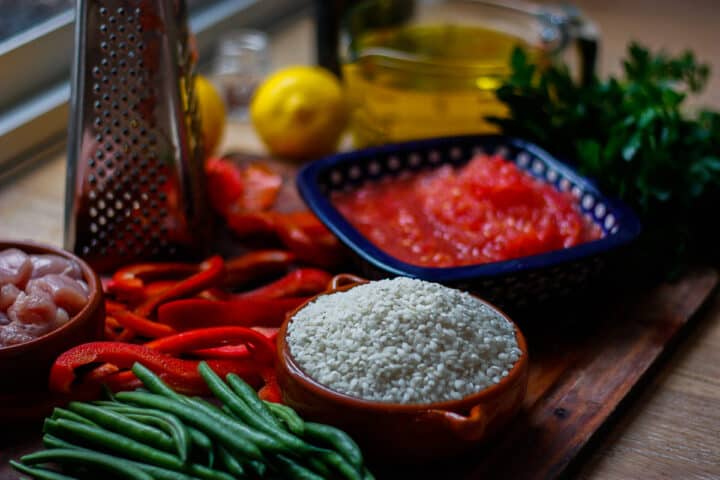
Is the saffron essential?
Yes! Famous for being more expensive than gold by weight, this beautiful fragrant spice gets a bad rap. The fact is, a little goes a very long way. You can get cheaper fake saffron with similar colour and (less) similar flavour. I wouldn’t recommend it though. Saffron adds wonderful colour to your stock and a very distinctive flavour. It’s worth the investment. It’s worth toasting before adding to the stock (as described in the recipe card below) to enhance the flavour.
What type of rice do you use for Paella?
We need to use short-grain rice (also known as pearl rice or round rice) as it absorbs liquid easily and won't dry out. Varieties of paella rice are Bomba (or ‘Valencian’) and Calasparra. These types of rice are renowned for their ability to absorb lots of water without turning mushy. Risotto rice (Arborio) is the most readily available type of short-grain rice. This works fine. It will end up a bit softer than ‘paella’ rice. You might prefer this. It is harder to source paella rice. You’re more likely to find it in specialist food stores (and it will cost quite a bit more).
Why do you put lemon juice on a paella?
Lemon juice helps cut through the richness of the dish. It makes the paella sing! Put some wedges around and let people squeeze their own over their steaming mound of paella. The kids love doing this.
🍽 Equipment
Can I make Paella if I don’t have a paella pan?
A shallow wide ceramic or metal frying pan will work fine. The idea is to have the rice in a thin layer so that it cooks evenly without stirring. You want lots of surface area to create the socarrat too. The diameter of the pan is the most important thing in determining how many portions you can cook at once. I cook this in a pan that measures 30cm across. It makes four portions. If I wanted to cook more, I would need a wider pan and a larger burner. This recipe is not easily scalable for this reason. It is important to use the largest burner you have on your stove-top and make sure you centre the pan. We want to see the whole surface simmering. The centre will likely be the hottest part. If you're successful in making soccarat, most of it will be found in the middle of the paella.
🔪 Instructions
It’s important to prep the ingredients before starting to cook the paella. This will take about 20 minutes. Then you’re only about 45 minutes away from dishing up!
- brown the chicken & sauté the beans and capsicum. Set aside
- make a sofrito (fried tomato paste)
- stir the rice (unrinsed) through the sofrito to flavour and toast the grains
- add hot stock. Stir through, then NO MORE STIRRING!
- lay chicken and veg on the top
- simmer until the rice is almost cooked and most of the stock has been absorbed
- crank up the heat to create a wonderful crisp bottom
- sprinkle with parsley and serve with lemon wedges
We brown bite-size pieces of chicken thighs really well and set aside. We DON’T clean the pan after. All the stuck-on chicken-y deliciousness will be incorporated later
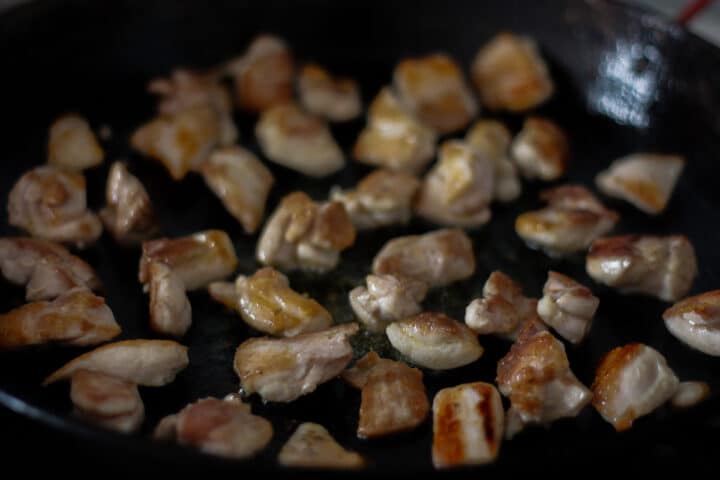
We sauté green beans and capsicum/pepper for a few minutes, until a little softened and scorched in spots. Set aside.
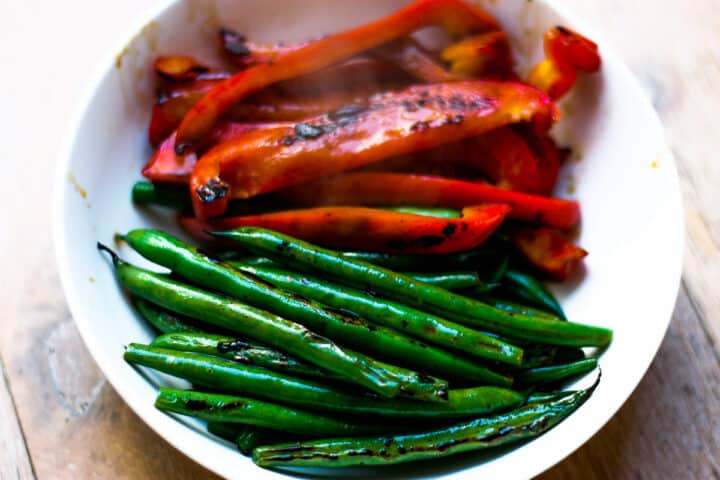
What’s a sofrito?
We peel and grate fresh tomato to get a tomato juice. This is ‘fried’ with olive oil over high heat to drive off the water and create a thick savoury paste. This intensifies the tomato flavour. It creates a wonderful coating of flavour for the rice before adding the rest of the ingredients
The photo on the left shows the tomato as it is added to the pan. The photo on the right is the finished sofrito. The water content has been cooked away and the tomato is darkened and intensely flavoured.
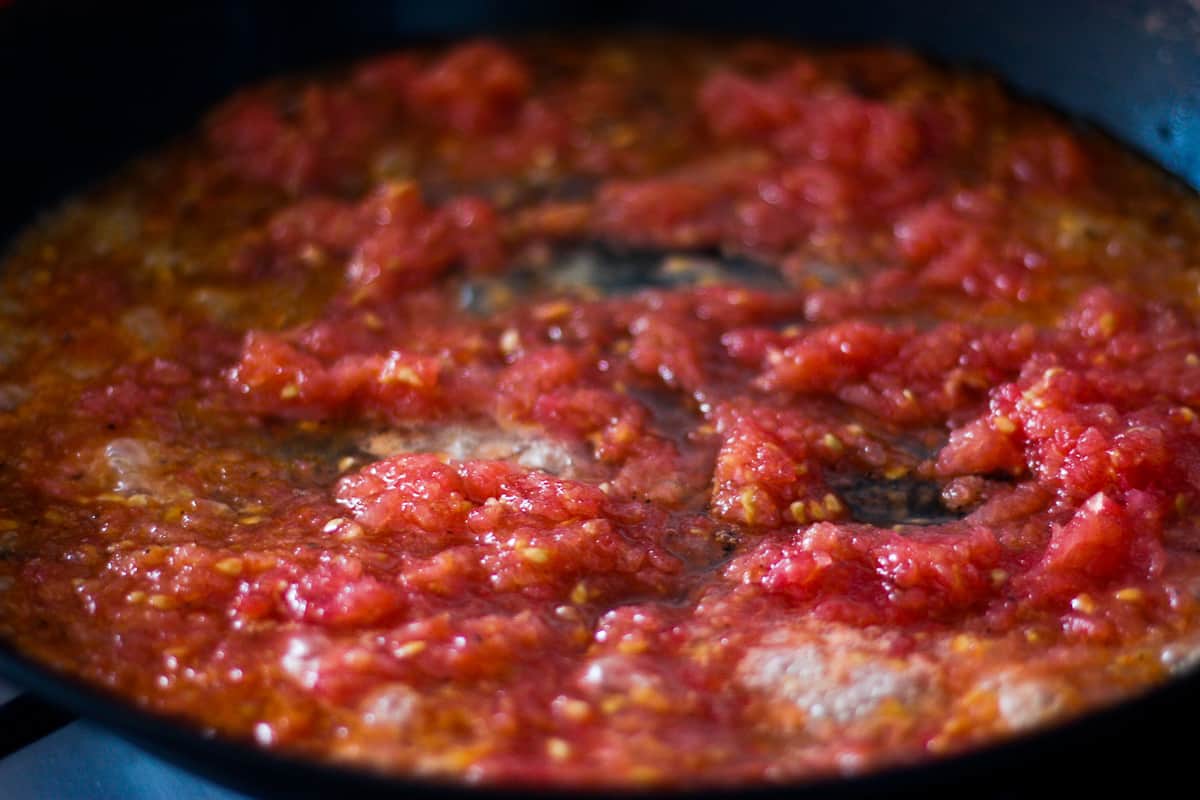
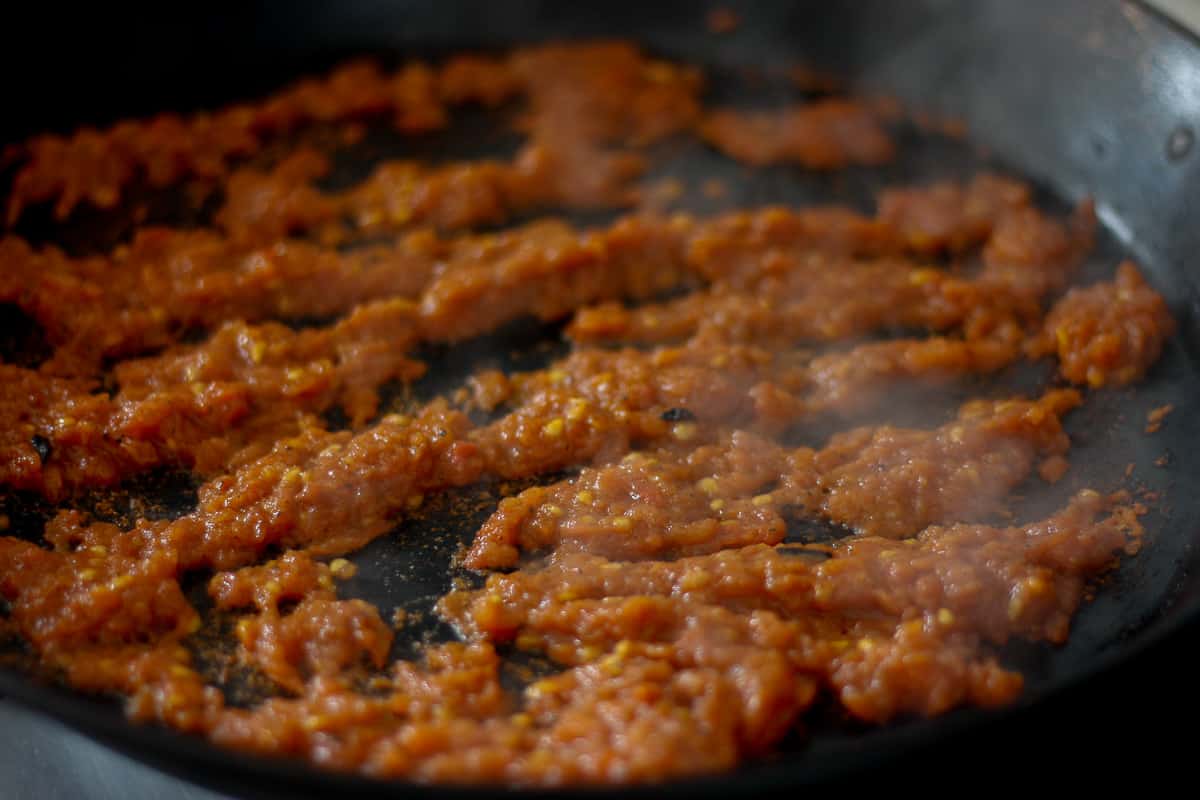
We stir through the rice to coat and toast
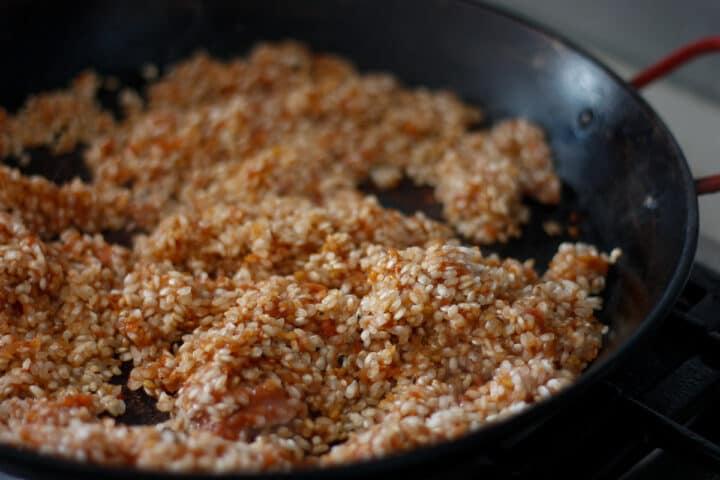
We pour over the saffron-infused hot stock. We make sure the rice is evenly spread and then we commit to NO MORE STIRRING! We lay the capsicum/pepper and green beans on top and the chicken pieces
Why don’t you stir a Paella?
Unlike risotto, stirring the rice is not encouraged. With paella, we’re aiming for a tender, but not creamy result. Paella rice should not be oozy. Besides, we wouldn’t develop the crust at the bottom of the pan if we stirred the rice. We achieve the soccarat by NOT stirring and allowing the rice to get hot and quite dry.
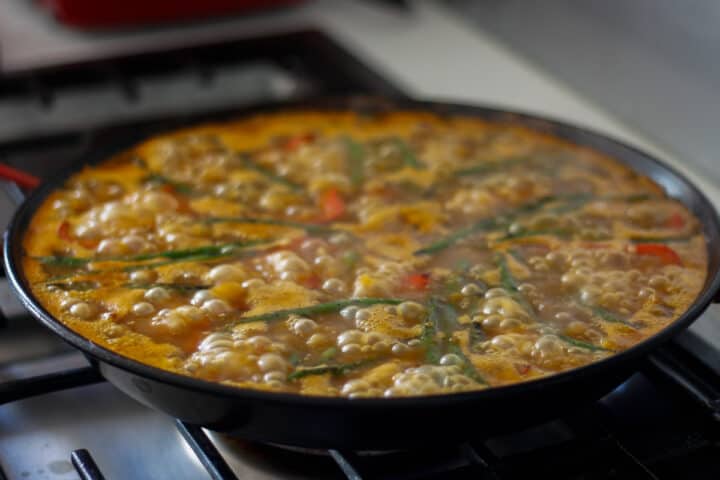
We simmer until the rice is almost cooked and most of the stock is absorbed. This takes 15-20 minutes.
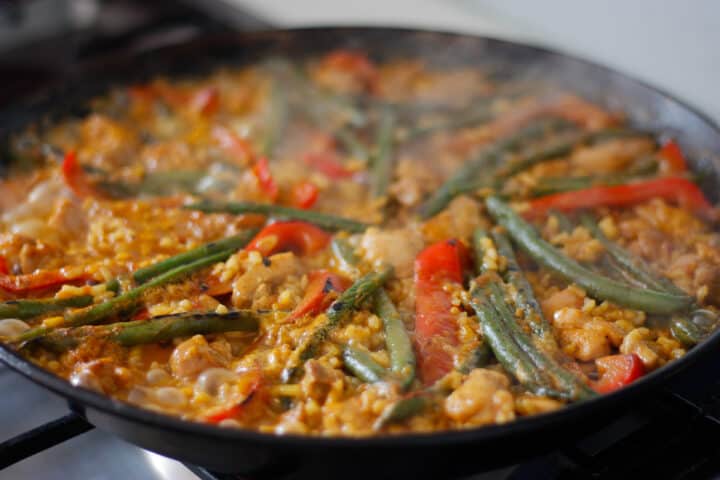
Once the paella is dry enough that liquid is only popping through gaps in the rice (see pic above), we can create a few holes with the end of a chopstick or wooden spoon handle and pour a little olive oil into the wells. Cook over high heat for a bit longer to toast the bottom and create a wonderful soccarat crust. We garnish with chopped parsley and lemon wedges to serve.
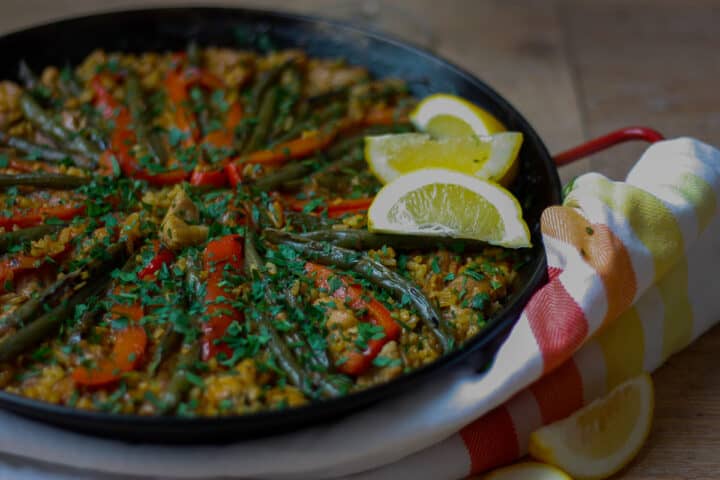
What’s the socarrat?
This is the crisp layer of rice that forms on the bottom of a well-cooked paella. It comes from the Spanish word for ‘singe’ or ‘scorch’. This is highly prized. It has great flavour because its caramelised and toasty. It adds a wonderful crunchy contrast to the rest of the rice and the other ingredients which are soft.
How do I know when I’ve achieved the socarrat?
We can use our eyes - turn a section of the rice to check for doneness. The socarrat is ready when the base is dry enough that only a little stock is bubbling between the rice grains. Use your other senses to guide you when it’s ready. It will sound more dry - more of a hissing, steaming sound coming from the pan. When you’ve cooked this a few times the paella will smell ready. Don’t take it too far beyond this stage to the point when you can smell charcoal. Despite the fact my husband calls it the ‘burnt bit’, it shouldn’t actually be black!
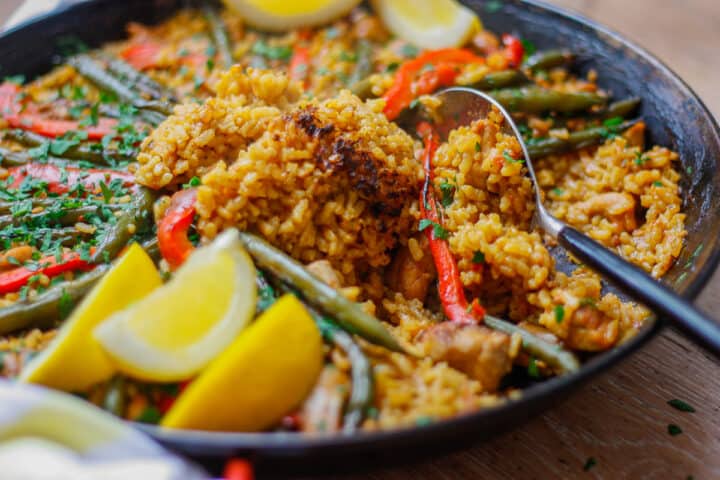
📖 Recipe
Equipment
- Wide/shallow pan measuring approximately 30cm across
Ingredients
*notes for low FODMAPPERS
- 1 ½ litres chicken or vegetable stock, *labelled low FODMAP (note)
- BIG pinch saffron strands
- 400 g chicken thighs, 3-4, skinless and boneless
- 430 g short grain rice, such as bomba or arborio
- 1 red capsicum/bell pepper, *no more than 170g prepped weight (note)
- Large handful green beans, about 150g
- 2 tomatoes, *no more than 250g total weight
- olive oil
- Large handful fresh parsley leaves
To Serve:
- lemon wedges
Instructions
Prep Ingredients
- Saffron Stock – make up the stock with hot water and set aside. Preheat a small dry frying pan over low-medium heat. Add the saffron threads. Toast the saffron for about 30 seconds, until darkened and fragrant. Be careful not to let it burn. Tip the strands into the hot stock and stir through. Set aside.BIG pinch saffron strands1 ½ litres chicken or vegetable stock, *labelled low FODMAP (note)
- Chop Chicken – trim away any excess fat and cut into bite-size pieces. Set aside.400 g chicken thighs, 3-4, skinless and boneless
- Weigh Rice – have rice weighed out, ready to pour into the pan. No need to rinse.430 g short grain rice, such as bomba or arborio
- Prep Capsicum/Pepper & Beans – De-seed the capsicum and cut into long strips. Trim the stalks (non-pointy ends) of the beans (but leave whole).1 red capsicum/bell pepper, *no more than 170g prepped weight (note)Large handful green beans, about 150g
- Grate Tomatoes – halve horizontally. Lay a box grater flat on a board with the largest holes uppermost. Use the flattened palm of your hand to ‘grate’ the cut edge of one tomato half. You’ll end up with tomato pulp inside the grater (tip out into a bowl) and the skin of the tomato left under your hand (discard). Repeat with the remaining tomato halves.2 tomatoes, *no more than 250g total weight
Make the Paella
- Brown Chicken – preheat the dry paella pan over high heat. Add two tablespoons of oil. Swirl this around the base of the pan. Carefully tip in and distribute the chicken pieces. Brown these well. Don’t worry about cooking them all the way through at this stage. Remove the chicken to a bowl once browned all over. DON’T clean the pan. We can incorporate all the stuck-on chicken bits later.olive oil
- Sauté Capsicum & Beans - reduce the heat; there will be a lot of residual heat in the pan. Add the capsicum/pepper and green beans. Toss them around and allow to scorch slightly. This will take a couple of minutes. Add a touch more oil if you need to. Remove the veg and set them aside.
- Fry Tomato Pulp - turn the heat back up to high. Add another 2 tablespoons of olive oil. Carefully add the tomatoes, which will hiss and spit. Use a flat-ended spatula to scrape any stuck-on chicken bits and incorporate these. Cook, stirring frequently, until the water has evaporated, around 5 minutes. The tomato will transform to a darker thick paste which will start to catch at the bottom of the pan. Keep it on the move.olive oil
- Toast Rice - add all the rice in one go and stir through thoroughly to coat and toast the grains, about 1 minute.
- Add Stock – pour in all the hot saffron-infused stock. Use the handle of an item of cutlery or fat end of a chopstick to wiggle grid lines across and then down the pan to evenly distribute the grains. These will be under the surface of the stock. We can’t see them, so have to feel our way. Do this quickly then commit to no more stirring.
- Veg & Chicken - lay the capsicum and green beans on the top, radiating from the centre of pan outwards. The stock will bubble furiously, so these will move; do the best you can. Sprinkle the chicken pieces evenly over the top of the rice. Pour in any chicken juices from the resting meat.
- Cook Rice – lower the heat to medium and continue to simmer until most of the stock has evaporated or been absorbed by the rice. The rice grains just under the surface should be softened but still have some bite. Position your pan evenly over the heat so that you can see simmering all the way around the pan. This will take about 15-20 minutes.
- Socarrat – when the rice is no longer until a layer of liquid and there is only some liquid bubbling through gaps, dot about 8 little holes around the paella with the handle of a wooden spoon or fat end of a chopstick. Fill these with a little olive oil. Turn the heat up to medium high. Cook until you can hear that the bottom of the pan is sizzling and dry. Be attentive to any crackling sounds and slightly scorched smells.olive oil
- Rest - turn the heat off and remove the pan from the heat. Cover the pan lightly with a clean cloth or foil for 5-10 minutes to keep it warm. This resting time allows the remaining liquid to be absorbed by the rice. It also helps the soccarat at the bottom to set slightly, making it easier to serve.Large handful fresh parsley leaves
- Serve - sprinkle with freshly chopped parsley. Make sure everyone gets some socarrat when you’re dishing up! Dig in to get a big spoon’s worth then tip it upside-down on the plate so that the socarrat is revealed. Serve with plenty of freshly squeezed lemon juice.lemon wedges

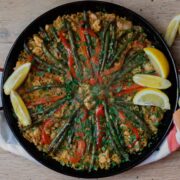


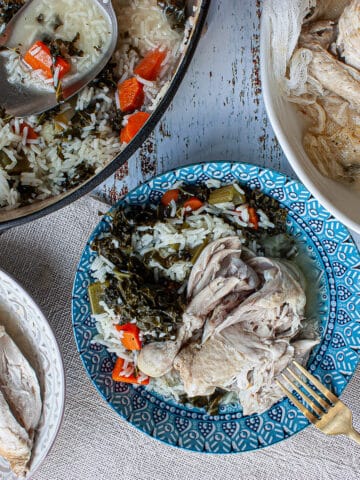

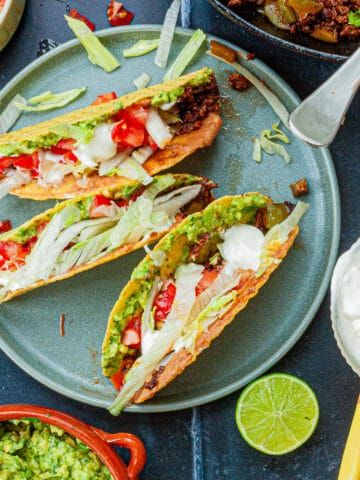
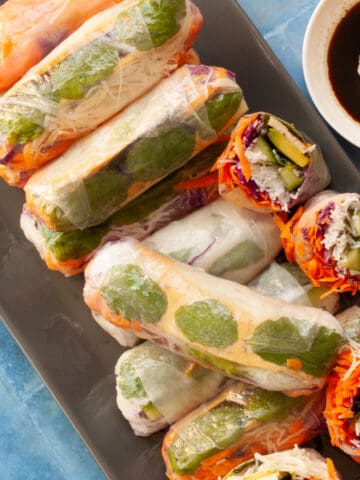

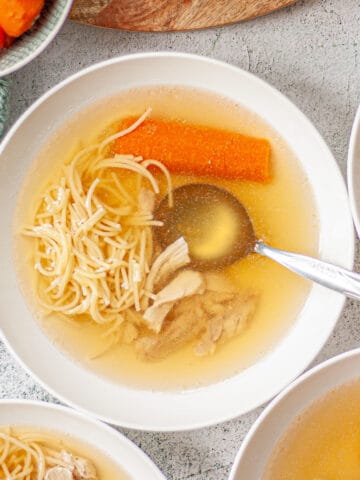
Comments